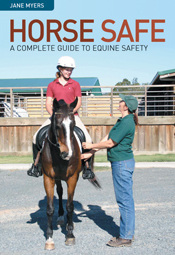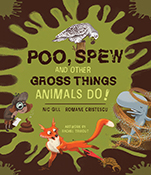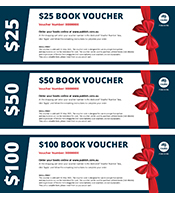Horse Safe
A Complete Guide to Equine Safety
By: Jane MyersA complete guide to equine safety endorsed by the Association for Horsemanship, Safety and Education (AHSE).
Horse riding is widely enjoyed as a professional sport or a hobby by riders of all ages. It is also acknowledged as being potentially dangerous, yet many of these dangers can be avoided and the severity of accidents drastically reduced if safe practices and risk management are employed. Horse Safe covers safety around horses in detail and aims to raise awareness of what can happen. + Full description
Beginning with an explanation of horses’ natural behavioural characteristics, such as herd behaviour, intelligence and body language, the author then presents the more human aspects of horse safety – safety equipment and how it should be maintained, the working environment, systems for safe horse management, safe riding, training for safe horses, and transporting horses safely. The book concludes with a chapter on how to reduce the risks when buying a horse and how to avoid potential pitfalls.
Written by Jane Myers, a leading expert, and endorsed by the Association for Horsemanship, Safety and Education (AHSE), Horse Safe is highly practical and is invaluable for riders of all disciplines and skill levels.
- Short descriptionNews
No longer available in a print edition.
Reviews
"Of all the information presented within the book, the section I wanted to rip out and put on our agistment noticeboard was the selection of your new horse. . . A list of questions that could be asked of the horse's sellers are given and I know I'll never go looking again without being armed with my list!. . . It should be compulsory reading for all of us dealing with horses on an occasional or daily basis. If after having read this book, it prevents just one accident it is most definitely time and money well spent."
Lisa-Jane Davis (Horses and People Magazine February 2006)
Details
ePDF | November 2005ISBN: 9780643093065
Publisher: Landlinks Press
Available from eRetailers
ePUB | November 2005
ISBN: 9780643099081
Publisher: Landlinks Press
Available from eRetailers
Features
- Covers the subject of safety around horses in detail
- Written by a leading expert and is endorsed by the AHSE
- Written for adults and older teenagers
- Highly practical and avoids jargon
- Well illustrated with clear and self explanatory photographs
Contents
Introduction1. Horse characteristics
Physical characteristics; Behavioural characteristics; Body language
2. Human physical requirements
3. Clothing and equipment
Helmets; Footwear; Clothing; Protection; Support
4. Facilities and environment
Access; Fences; Gateways; Stables, shelters & holding yards; Training yards & arenas; Air quality in stables; Fire & electrical safety
5. Safe horse handling
Halters & leadropes; Basic horse management requirements; Catching a horse; Leading a horse; Tying up a horse; Moving around horses; Grooming; Applying insect repellents; Handling the legs & hooves; Hoof care; Handling the mouth; Dental care; Feeding; Rugging; Parasite protection; Inoculations & injections; Working alone; Assisting another person; Restraining a horse; Releasing a horse; Common handling problems
6. Safe gear and tacking up
Bridles; Martingales & breastplates; Saddles; Wear & tear gear checks; Maintenance of gear
7. Safe Riding
Mounting; Dismounting; Riding; Falling off; Improving skills; Choosing a place to learn to ride; Common riding problems; Exercise levels
8. Training for safe horses
Horse/human relationships; Where to work a horse; Training session length & intensity; Training horses on the ground; Training under saddle; Training methods
9. Transport
Vehicle safety; General considerations; Hitching a trailer; Packing for a trip; Horse travelling gear; Loading horses; Unloading; Travelling safely
10. Selecting horses
Considerations; Methods of buying; Buying process; Collecting a horse; Selling a horse
Appendix 1: Useful contacts
Appendix 2: Safe instructing
Glossary
Bibliography
Index
Authors
Jane Myers has worked in the horse industry for over 30 years and has a Masters Degree in Equine Studies from the University of Wales. She has conducted research at the world famous Edinburgh University School of Veterinary Science and worked as a lecturer in equine studies at the University of Melbourne, Glenormiston College. She has studied horse behaviour intensively and has a deep commitment to horse welfare and training methods that foster a more responsible relationship between the rider, the horse and its environment. She has written numerous articles on horse keeping for magazines and newspapers on various subjects such as horse property management, horse behaviour, horse riding and safety. Jane is an Executive board member of Horse Safety Australia.Horse Safety Australia was formed in 1992 (then called the Association for Horsemanship Safety and Education) to foster higher standards of safety within the horse industry, particularly relating to teaching horse riding to groups of beginners. It is responsible for accrediting instructors in Queensland, NSW, Victoria and South Australia. Certification by Horse Safety Australia has been described as appropriate for instructing horse riding in the Education Department Guidelines to schools in Queensland, Tasmania, NSW, ACT, Victoria and South Australia. Horse Safety Australia also helped with the development of the units of competency in the National Training Package for the recreational horse riding industry. Clusters of these units are expected to form the basis of registration in recreational horse riding with the National Outdoor Recreation Leaders scheme.








